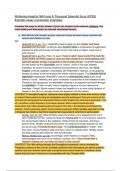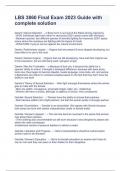Wuthering Heights (WH) and A Thousand Splendid Suns (ATSS)
thematic essay comparison examples:
Compare the ways in which writers of your two chosen texts examine violence. You
must relate your discussion to relevant contextual factors.
● Both Bronte and Hosseini explore violence through domestic abuse towards both
women and children by men.
WH
- Heathcliff (C14, pg. 111): Heathcliff is said by Nelly to have ‘seized, and thrust
[Isabella] from the room’, as Bronte uses dynamic verbs to emphasise his aggression
towards his wife and the way he treats her as if she were an object, easily free to
push around.
- Heathcliff (C14, pg.111): Then, he says: ‘I have no pity! I have no pity! The more the
worms writhe, the more I yearn to crush our their entrails! It is a moral teething; and I
grind with greater energy, in proportion to the increase of pain.’ Heathcliff degrades
his wife further by the zoomorphic use of ‘worms’, which in his eyes Isabella
embodies. As worms connote weakness and puniness by their size, this visual
imagery contrasts Isabella’s vulnerability with Heathcliffe’s violence, as he graphicly
asserts his desire to kill and expose the worms’ internal organs. The semantic field of
aggression emphasises Heathcliff’s violence as onomatopoeic verbs such as his
desire to ‘crush’, ‘teething’ and ‘grind’ increases ‘in proportion to the increase of pain.’
Therefore, the repugnancy of Heathcliffe’s violence is increased even further through
the repetition of ‘I have no pity!’ twice, creating a figure of not just violence but
merciless. Overall, Bronte makes it clear that Isabella is in an ever-rising situation of
danger to her life in a marriage where she appears to be the inferior.
CONTEXT: In Georgian England, husbands were legally entitled to strike their wives in order
to ‘correct’ their conduct so long as moderation was the watchword. Spousal violence at this
time was not recognised as a separate offence under English law, and was prosecuted – if at
all – as either a petty dispute or a common assault. When violent husbands were
prosecuted, they often pleaded guilty and paid a 12d. fine – the standard punishment for
assault – before returning, again, to the marital household. Infact, Hindley says that ‘no law
in England can hinder a man from keeping his house decent, and [his] is abominable!’
- Hindley (C9, pg. 52): When Hindley enters the kitchen, he is angered by his son’s
lack of affection for him, saying he deserves ‘flaying alive’ for not running to welcome
him (to be flayed refers to the outdated, medieval form of execution- skinning a
person alive). Hindley continues this theme of cruelty and murder towards his own
son as he says: ‘I’ll break the brat’s neck.’ The continued plosives in ‘break’, ‘brat’
and ‘neck’ convey Hindley’s spite and force, which is realised when Hindley carries
his baby upstairs and holds him over the bannister.
- Nelly to Hindley (C9, pg. 53): Accordingly, when Hareton is dropped, Nelly
acknowledges the horror of his violence, saying to him: ‘You’re worse than a
heathen- treating your own flesh and blood in that manner!’
CONTEXT: The 18th century brought the Evangelical movement, which promoted the
Protestant customs of the Church. Christian pacifism is the theological and ethical position-
pacifism and non-violence have both a scriptural and rational basis for Christians, which
means that any form of violence is incompatible with the Christian faith.
, As a ‘heathen’ refers to those who do not practice Christianity, Nelly associates
Hindley’s violence with his lack of faith. To a contemporary audience, to be violent towards
one’s children would be an abondible act, which is reflected through Nelly’s reaction.
ATSS
- Rasheed (C15, pg. 103): The language in this section is full of connotations of
violence. The semantic field of force shows Rasheed’s power through violence:
‘snatched’, ‘powerful’, ‘clasped’, ‘shoved’, ‘pried’, ‘forced’, ‘pushing’. As Mariam is
forced to eat pebbles as punishment, the monosyllabic, exclamatory imperative
‘CHEW!’ further emphasises the seriousness to which Rasheed regards
punishments. This is capitalised as he ‘bellows’ the imperative to convey his control
and fear tactics. Accordingly, Mariam complies, and is left to ‘spit out pebbles, blood,
and the fragments of two broken molars.’ This graphic imagery shows the extent of
Mariam’s pain as a result of his violence.
- Rasheed (C36, pg. 262): After Laila and Mariam are returned to their home, Laila
describes the abuse that Mariam receives. The dramatic impact of Laila’s narrative is
that the reader cannot know the full extent of Rasheed’s violence. Instead, Laila
describes ‘the sounds she heard were those of methodical, familiar proceeding.
There was no cursing, no screaming, no pleasing, no surprised yelps, only the
systematic business of beating and being beaten, the thump, thump of something
solid..’ The onomatopoeic words ‘thump, thump’ emphasise the extent of Rasheed’s
brutality, as the semantic field of structure in the phrases ‘methodical’, ‘familiar
proceeding’ and ‘systematic business’ suggest that his violence is a mere formality
for her disregarding his honour (article 398). Moreover, her passivity to this violence-
suggested through the asyndetic list- implies that she accepts her inferior position in
society and that she isn’t ‘surprised’ (again, perhaps due to article 398). As Lailia
describes the sound being like ‘a wooden club repeatedly slapping a side of beef’,
the simile further subverts Mariam from a human being to a piece of dead meat.
Accordingly, the wooden club has connotations of primitivity, suggesting that they
share a rudimentary, primitive relationship in a society which allows women to be
comparable to passive meat whilst men are the embodiment of weapons.
CONTEXT: Article 398 of the Afghan penal code states that a man who sees “his wife or
other family members” in a compromising position and kills or injures one or both of them “in
order to defend his dignity and respect” will not be prosecuted for violent assault or murder.
- Rasheed (C36, pg. 261-5): Not only does Rasheed inflict violence upon his two
wives, but his (believed) ‘daughter’ too. When Laila and Mariam are brought home,
Rasheed ‘lifted’ and ‘flung’ Aziza onto the bed. These dynamic verbs convey the
ease at which Rasheed treats his baby, which is worsened as he leaves Laila and
Aziza locked in a hot, dark room for days, without water or food. Finally, when they
are released, Rasheed alludes to further violence as he threatens to inflict violence
onto ‘Mariam first, then to her [Aziza], then you [Laila] last’. Accordingly, he alludes to
the loose justice system in relation to women by saying that there ‘isn’t a court in this
godforsaken country which will hold [him] accountable’ for his violence towards the
three females. When Aziza is older, Rasheed ‘slaps’ her whilst he ‘kicks’ her mother,
showing the extent to which Rasheed feels free to use his violence.
● Both Bronte and Hosseini explore violence through female retaliation towards men as
a means of gaining freedom.
, WH
- Isabella (C17, pg.132): After Isabella claims that Catherine would have grown to hate
Heathcliff were she to marry him, Heathcliff attempts to control his wife through
violence once again: ‘he snatched a dinner knife from the table and flung it at my
head’. However, Isabella, despite her vulnerability in this unequal marriage, does not
remain passive. Instead, she recounts to Nelly that she pulled out the knife, ‘sprang
to the door and delivered another’, hoping it would go ‘a little deeper than his missile.’
However, we must note that this retaliation of violence would not go unnoticed unlike
Heathcliff’s. Isabella must flee and escape Heathcliff after she stands up to him, so it
is far from a complete reversal of roles due to the society she is in.
CONTEXT: The Divorce and Matrimonial Causes Act 1857 was a landmark step in women's
emancipation. The Divorce and Matrimonial Causes Act 1857 gave women in England and
Wales legal standing to use the civil courts to seek a decree of divorce or nullity, enabling
them to leave unhappy unions and remarry. Before this, a divorce could only be proposed by
the man (the temporal setting of the novel at the time of their marriage was late 18th
century).
ATSS
- Mariam (C45, pg. 341): After Rasheed attacks Laila for meeting Tariq, Rasheed
begins to strangle her. Mariam, realising that Rasheed intends to murder Laila, kills
him with shovel, giving it ‘everything she had’. This outburst of violence through
retaliation means that for Mariam, she realises ‘that this was the first time she was
deciding the course of her own life.’ Therefore, Rasheed’s death, despite being a
violent, hateful action, is symbolic of Mariam’s new-found liberty.
- Mariam (C47, pg. 349): However, like Isabella, Mariam will have to face
repercussions for her violence unlike men. Lailia implies this: ‘They chop off hands
for stealing bread’, Mariam said. ‘What do you think they’ll do when they find a dead
husband and two missing wives?’ The rhetorical question alludes to the strict laws
imposed by the Taliban, who themselves use violence to maintain their control.
CONTEXT: The Taliban enforced their version of Islamic Sharia law. Women and girls were
banned from going to school or studying, working, leaving the house without a male
chaperone, showing their skin in public, accessing healthcare delivered by men (with women
forbidden from working, healthcare was virtually inaccessible), and banned from being
involved in politics or speaking publicly. If she disobeyed these discriminatory laws,
punishments were harsh. A woman could be flogged for showing an inch or two of skin
under her full-body burqa, beaten for attempting to study, stoned to death if she was found
guilty of adultery. Therefore it is not surprising that Mariam is executed for her crime.





